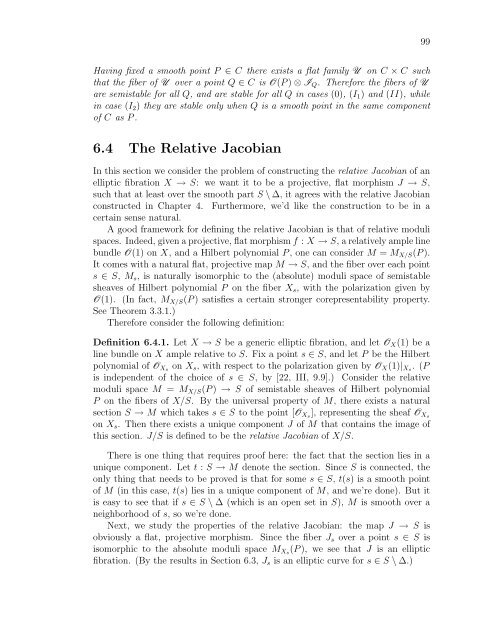derived categories of twisted sheaves on calabi-yau manifolds
derived categories of twisted sheaves on calabi-yau manifolds
derived categories of twisted sheaves on calabi-yau manifolds
You also want an ePaper? Increase the reach of your titles
YUMPU automatically turns print PDFs into web optimized ePapers that Google loves.
Having fixed a smooth point P ∈ C there exists a flat family U <strong>on</strong> C × C such<br />
that the fiber <str<strong>on</strong>g>of</str<strong>on</strong>g> U over a point Q ∈ C is O(P ) ⊗ IQ. Therefore the fibers <str<strong>on</strong>g>of</str<strong>on</strong>g> U<br />
are semistable for all Q, and are stable for all Q in cases (0), (I1) and (II), while<br />
in case (I2) they are stable <strong>on</strong>ly when Q is a smooth point in the same comp<strong>on</strong>ent<br />
<str<strong>on</strong>g>of</str<strong>on</strong>g> C as P .<br />
6.4 The Relative Jacobian<br />
In this secti<strong>on</strong> we c<strong>on</strong>sider the problem <str<strong>on</strong>g>of</str<strong>on</strong>g> c<strong>on</strong>structing the relative Jacobian <str<strong>on</strong>g>of</str<strong>on</strong>g> an<br />
elliptic fibrati<strong>on</strong> X → S: we want it to be a projective, flat morphism J → S,<br />
such that at least over the smooth part S \ ∆, it agrees with the relative Jacobian<br />
c<strong>on</strong>structed in Chapter 4. Furthermore, we’d like the c<strong>on</strong>structi<strong>on</strong> to be in a<br />
certain sense natural.<br />
A good framework for defining the relative Jacobian is that <str<strong>on</strong>g>of</str<strong>on</strong>g> relative moduli<br />
spaces. Indeed, given a projective, flat morphism f : X → S, a relatively ample line<br />
bundle O(1) <strong>on</strong> X, and a Hilbert polynomial P , <strong>on</strong>e can c<strong>on</strong>sider M = MX/S(P ).<br />
It comes with a natural flat, projective map M → S, and the fiber over each point<br />
s ∈ S, Ms, is naturally isomorphic to the (absolute) moduli space <str<strong>on</strong>g>of</str<strong>on</strong>g> semistable<br />
<str<strong>on</strong>g>sheaves</str<strong>on</strong>g> <str<strong>on</strong>g>of</str<strong>on</strong>g> Hilbert polynomial P <strong>on</strong> the fiber Xs, with the polarizati<strong>on</strong> given by<br />
O(1). (In fact, MX/S(P ) satisfies a certain str<strong>on</strong>ger corepresentability property.<br />
See Theorem 3.3.1.)<br />
Therefore c<strong>on</strong>sider the following definiti<strong>on</strong>:<br />
Definiti<strong>on</strong> 6.4.1. Let X → S be a generic elliptic fibrati<strong>on</strong>, and let OX(1) be a<br />
line bundle <strong>on</strong> X ample relative to S. Fix a point s ∈ S, and let P be the Hilbert<br />
polynomial <str<strong>on</strong>g>of</str<strong>on</strong>g> OXs <strong>on</strong> Xs, with respect to the polarizati<strong>on</strong> given by OX(1)|Xs. (P<br />
is independent <str<strong>on</strong>g>of</str<strong>on</strong>g> the choice <str<strong>on</strong>g>of</str<strong>on</strong>g> s ∈ S, by [22, III, 9.9].) C<strong>on</strong>sider the relative<br />
moduli space M = MX/S(P ) → S <str<strong>on</strong>g>of</str<strong>on</strong>g> semistable <str<strong>on</strong>g>sheaves</str<strong>on</strong>g> <str<strong>on</strong>g>of</str<strong>on</strong>g> Hilbert polynomial<br />
P <strong>on</strong> the fibers <str<strong>on</strong>g>of</str<strong>on</strong>g> X/S. By the universal property <str<strong>on</strong>g>of</str<strong>on</strong>g> M, there exists a natural<br />
secti<strong>on</strong> S → M which takes s ∈ S to the point [OXs], representing the sheaf OXs<br />
<strong>on</strong> Xs. Then there exists a unique comp<strong>on</strong>ent J <str<strong>on</strong>g>of</str<strong>on</strong>g> M that c<strong>on</strong>tains the image <str<strong>on</strong>g>of</str<strong>on</strong>g><br />
this secti<strong>on</strong>. J/S is defined to be the relative Jacobian <str<strong>on</strong>g>of</str<strong>on</strong>g> X/S.<br />
There is <strong>on</strong>e thing that requires pro<str<strong>on</strong>g>of</str<strong>on</strong>g> here: the fact that the secti<strong>on</strong> lies in a<br />
unique comp<strong>on</strong>ent. Let t : S → M denote the secti<strong>on</strong>. Since S is c<strong>on</strong>nected, the<br />
<strong>on</strong>ly thing that needs to be proved is that for some s ∈ S, t(s) is a smooth point<br />
<str<strong>on</strong>g>of</str<strong>on</strong>g> M (in this case, t(s) lies in a unique comp<strong>on</strong>ent <str<strong>on</strong>g>of</str<strong>on</strong>g> M, and we’re d<strong>on</strong>e). But it<br />
is easy to see that if s ∈ S \ ∆ (which is an open set in S), M is smooth over a<br />
neighborhood <str<strong>on</strong>g>of</str<strong>on</strong>g> s, so we’re d<strong>on</strong>e.<br />
Next, we study the properties <str<strong>on</strong>g>of</str<strong>on</strong>g> the relative Jacobian: the map J → S is<br />
obviously a flat, projective morphism. Since the fiber Js over a point s ∈ S is<br />
isomorphic to the absolute moduli space MXs(P ), we see that J is an elliptic<br />
fibrati<strong>on</strong>. (By the results in Secti<strong>on</strong> 6.3, Js is an elliptic curve for s ∈ S \ ∆.)<br />
99
















